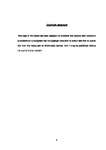The Effects of Lactobacillus plantarum NCIMB 41607 on Salmonella infection and the microbial population in the gastrointestinal tract of the chicken
| dc.contributor.supervisor | Beal, Jane | |
| dc.contributor.author | Wali, Nabil Ali | |
| dc.contributor.other | Faculty of Science and Engineering | en_US |
| dc.date.accessioned | 2013-01-22T11:58:51Z | |
| dc.date.available | 2013-01-22T11:58:51Z | |
| dc.date.issued | 2012 | |
| dc.date.issued | 2012 | |
| dc.identifier | 10199285 | en_US |
| dc.identifier.uri | http://hdl.handle.net/10026.1/1246 | |
| dc.description.abstract |
Salmonellosis is a foodborne disease, poultry and poultry products are the main source of the disease. Many countries including Iraq still use antibiotics to control Salmonella. The increase in antibiotic resistant bacteria putatively caused by the overuse of antibiotics in agriculture has provided the incentive to look for alterna-tives to antibiotic to control diseases in livestock. Lactic acid bacteria with probiotic characteristics have the potential to beneficially affect the gut microflora of chick-ens and help reduce the incidence of Salmonella infection. In this study, Lactobacillus plantarum NCIMB 41607 was examined in vitro for in-hibitory effects against Salmonella and in vivo for its effects on the gut microflora and on the incidence of Salmonella infection. In separate studies Lb. plantarum was administered to chicks as fermented moist feed (containing 175 mmol/L lactic acid and 1x109 CFU/g of Lb. plantarum), in drinking water or applied to dry feed. Rifampicin resistance was used as a biomarker for the Lb. plantarum NCIMB 41607. Traditional and molecular microbiology including DGGE, RISA, and FISH were used with electron microscopy to assess the effect of Lb. plantarum on bac-terial population in the digestive system of chicks. Lactobacillus plantarum (NCIMB 41607) was found to reduce the growth of Salmonella Typhimurium and Salmonella Enteritidis by 4 Log CFU/g in a chicken simulated digestive system in vitro. The presence of rifampicine resistant Lactobacillus plantarum in the gut was con-firmed by replica plating and fluorescent in situ hybridisation with a strain specific probe. In general, the bacterial population in the guts of chicks fed Lactobacillus plantarum was more diverse in the guts of chicks fed control feed. There was no significant effect on Salmonella infection in Ross chicks compared with control. However, with specific pathogen free chicks the Salmonella infection was reduced. The intestinal villi lengths in FMF group were increased. These studies demonstrate that probiotics can affect the microflora in the chicken gut. Lactobacillus plantarum NCIMB 41607 may have the potential to control of Salmonella Typhimurium infection in chicken and continued research is advised. | en_US |
| dc.description.sponsorship | Iraqi ministry of higher education, Baghdad and I. | en_US |
| dc.language.iso | en | en_US |
| dc.publisher | University of Plymouth | en_US |
| dc.subject | Probiotics | |
| dc.subject | Chicken | |
| dc.subject | Lactobacillus plantarum | |
| dc.subject | Antibiotic resistance | |
| dc.subject | Salmonella | en_US |
| dc.title | The Effects of Lactobacillus plantarum NCIMB 41607 on Salmonella infection and the microbial population in the gastrointestinal tract of the chicken | en_US |
| dc.type | Masters | en_US |
| plymouth.version | Full version | en_US |
Files in this item
This item appears in the following Collection(s)
-
01 Research Theses Main Collection
Research Theses Main


